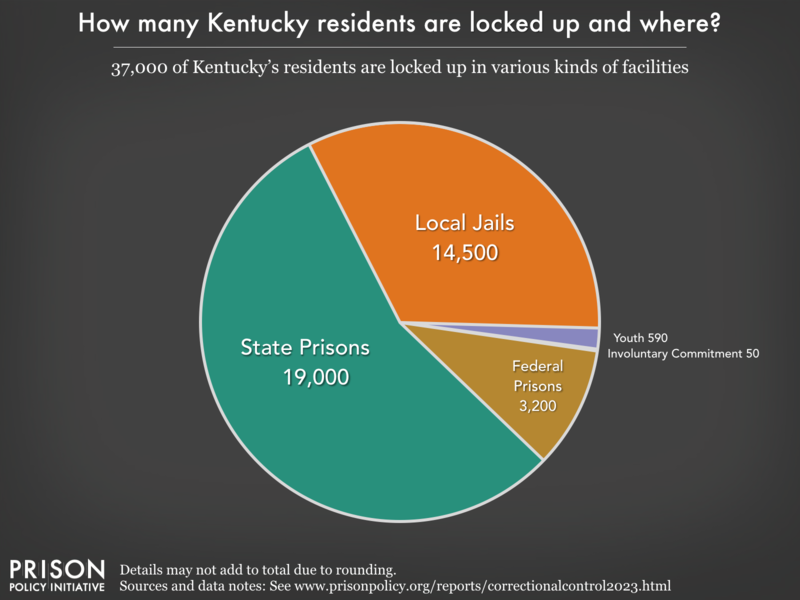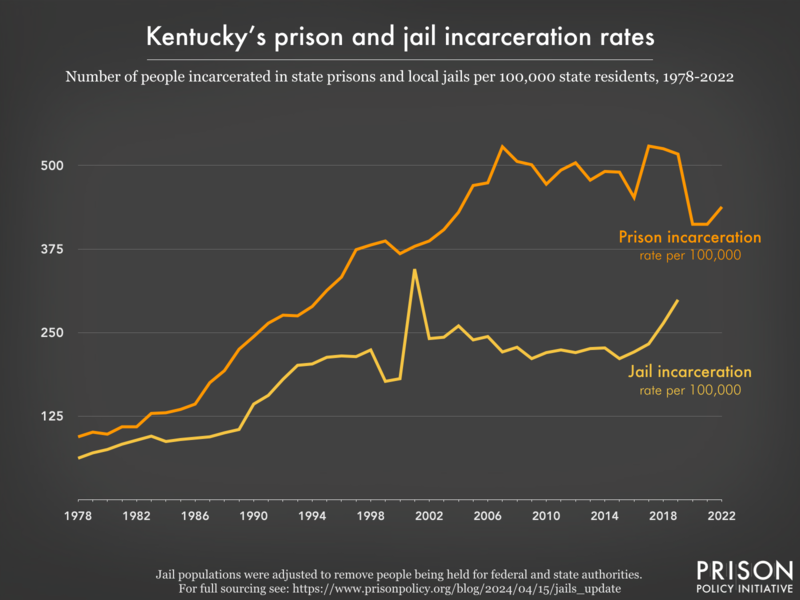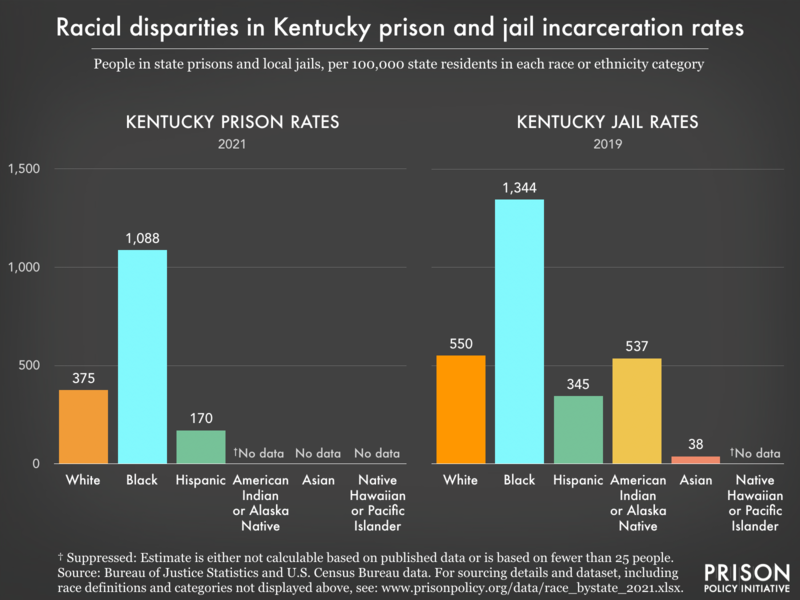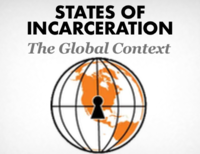Thank you,
—Peter Wagner, Executive Director
Donate
Kentucky profile
Kentucky has an incarceration rate of 889 per 100,000 people (including prisons, jails, immigration detention, and juvenile justice facilities), meaning that it locks up a higher percentage of its people than any independent democratic country on earth. Read on to learn more about who is incarcerated in Kentucky and why.
37,000 people from Kentucky are behind bars
Additionally, the number of people impacted by county and city jails in Kentucky is much larger than the graph above would suggest, because people cycle through local jails relatively quickly. Each year, at least 89,000 different people are booked into local jails in Kentucky.
Rates of imprisonment have grown dramatically in the last 40 years
More than third of the people held in jails in Kentucky are held for federal or state agencies, primarily the state prison system. To avoid counting them twice, this population is not included in the yellow jails line. For annual counts of people in jails held for federal or state authorizes in Kentucky, see our table "Jail and prison incarcerated populations by state over time." Also see these Kentucky graphs:
- total numbers rather than rates.
- Women’s prisons: Incarceration Rates | Total Population
- Men’s prisons: Incarceration Rates | Total Population
This graph excludes people held for state or federal authorities from the total count of people held in Kentucky jails. Because a tremendous proportion (43%) of the population in Kentucky’s jails is held for the state prison system, this graph likely overstates the convicted population and understates the pre-trial population.
Today, Kentucky’s incarceration rates stand out internationally

People of color are overrepresented in prisons and jails
These graphs use U.S. Census data for all people incarcerated in the state, including people in federal and state prisons, local jails, halfway houses, etc. While state and local facilities contain people processed by the Kentucky judicial systems, the federal prisons contain people sent to those facilities by courts all over the country.
For our purposes, the fact that federal prison populations are included in the Census Bureau's data as residents of Kentucky would be an unimportant statistical quirk except for that fact that there are so many people in federal prisons in Kentucky. In fact, 20% of the incarcerated people that the Census counted in Kentucky were in a federal prison. This has a dramatic impact of the demographics of the incarcerated population. If the Census Bureau's federal prison counts were removed from this analysis, the incarceration rates would be 628 for Whites, 625 for Hispanics, 2397 for Blacks, and 1023 for American Indian and Alaska Natives.
Kentucky's criminal justice system is more than just its prisons and jails

Reports and briefings about Kentucky's criminal legal system:
Filter to show
- People on probation in Kentucky are saddled with onerous rules and conditions they must follow every day or risk incarceration.
- Prisons in Kentucky have tablets, but they may be being used to restrict incarcerated people’s access to books and sap them of the little money they have.
- With an incarceration rate of 889 per 100,000 residents, Kentucky locks up a higher percentage of its people than any independent democratic country on earth.
- After the Dobbs’ decision, striking down Roe v. Wade, Kentucky totally banned abortion, putting access to the service effectively out of reach for the 19,100 women on probation or parole in the state who also face travel restrictions.
- Prisons in Kentucky force incarcerated people and their families — some of the most vulnerable members of society — to subsidize mass incarceration.
- 44% of people in Kentucky jails have not been convicted of a crime, meaning they're legally innocent. There are simple steps the state can take to reduce this number. Why isn't it?
- Kentucky releases roughly 225,022 men and 86,079 women from its prisons and jails each year. What is it doing to support them upon reentry?
- People on parole in Kentucky can be sent back to prison for "associating" with anyone who has a felony conviction — even loved ones who are trying to support them
- The parole board in Kentucky is releasing 14% fewer people and holding 38% fewer hearings since the pandemic started
- Black people in Kentucky are incarcerated at a rate 2.9 times higher than white people.
- Kentucky's choice to criminalize "failure to appear" may be hurting public safety
- The cost of incarcerating older people is incredibly high, and their risk of reincarceration is incredibly low, yet 10% of people in Kentucky prisons are over the age of 55. Why is the state keeping so many older people locked up?
- Data from Kentucky and other jurisdictions shows: Releasing people pretrial doesn't harm public safety
- Kentucky makes it difficult or even risky for incarcerated journalists to tell their stories.
- Kentucky charges up to 44¢ for an e-message to or from prison, among the highest rates in the nation.
- Jails in Kentucky charge up to $3.15 for a 15-minute phone call, reaping profits for companies, while prisons charge $2.10 for a 15-minute call.
- Some Kentucky prisons are replacing incarcerated people's personal mail with scans, stifling family contact
- How the end of Roe v. Wade will impact the 17,720 women on probation and parole in Kentucky
- In Kentucky, 37,000 people are incarcerated and another 67,000 are on probation or parole.
- Some prisons in Kentucky are sited on uninhabitable, toxic wastelands
- Kentucky suspended its $3 medical copays in prisons at the beginning of the pandemic for flu related medical visits — but should eliminate them entirely
- People in Kentucky prisons with less than $5 in their commissary and media accounts combined receive postage and writing supplies but must pay for basic hygiene products
- Kentucky prisons and Access Corrections don’t report data on fees to transfer money to an incarcerated loved one.
- We gave Kentucky a failing grade in September 2021 for its response to the coronavirus in prisons.
- Kentucky hurts jury diversity by excluding people with felony records
- How many COVID-19 cases in Kentucky communities can be linked to outbreaks in correctional facilities? (data from our report Mass Incarceration, COVID-19, and Community Spread)
- We graded the parole release systems of all 50 states - Kentucky gets an F
- Cruel and unusual punishment: When Kentucky prisons don't provide air conditioning
- Kentucky incarcerates women at a rate of 241 per 100,000 residents — higher than any democratic country on earth.
- People in Kentucky prisons earn as little as 13¢ an hour for their work.
Other resources
- Research on Kentucky in our Research Library
- Ending prison gerrymandering in Kentucky campaign and resource page








